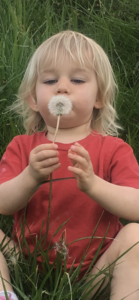 Earth Day falls on April 22 every year and I’m often tempted to celebrate it all month long in this column. But April is also Poetry Month, which is worth celebrating, too. What to do, what to do?
Earth Day falls on April 22 every year and I’m often tempted to celebrate it all month long in this column. But April is also Poetry Month, which is worth celebrating, too. What to do, what to do?
It took me several long walks in the glorious spring sunshine to solve the dilemma. My answer? Celebrate both! To kick things off, I’ll begin with one of my favorite poems, “Nothing Gold Can Stay” by American poet Robert Frost, first published in 1923 in The Yale Review. It goes like this:
Nature’s first green is gold,
Her hardest hue to hold.
Her early leaf’s a flower;
But only so an hour.
Then leaf subsides to leaf.
So Eden sank to grief,
So dawn goes down to day.
Nothing gold can stay.
By this time in April, much of our early-spring gold has disappeared. Crocus blooms are long gone. Most of the daffodils are, too. Forsythia bushes are already almost entirely green.
But there’s one yellow flower that’s just getting started: the much-hated/much-beloved/much-misunderstood dandelion. Considered a stubborn weed by some and a miracle plant by others, dandelions are showing their bright yellow faces everywhere these days. I’m on the team that loves them, for a million different reasons. For starters, they’re just so darn cheerful—quarter-sized dots of sunshine blooming wherever you look.
Although it’s not easy to get rid of dandelions, plenty of folks expend a whole lot of effort trying. They attempt to dig them up by the roots, which is almost impossible because the taproot of a dandelion can extend 15 feet underground. That’s actually very good news, because dandelion roots improve soil quality by aerating hard-packed dirt. They also pull calcium from the soil to share with other plants. The other widely-used weapon against dandelions is poison, which ranks right up there with one of the worst ideas ever. Weeds aren’t the only thing garden poisons destroy. They’re almost certainly harmful to humans, birds, pets and other animals. And they’re devastating to pollinators, including butterflies and bees.
Why not eat dandelions instead of trying to eradicate them?
Dandelions leaves can be enjoyed raw in salads or sautéed in olive oil with a pinch of garlic and served as a side dish. Enthusiasts believe that including dandelions in your diet leads to better gut health, reduced inflammation, management of blood sugar, weight loss, reduced cholesterol and triglyceride levels and lower blood pressure. They’re full of vitamins and minerals. Dandelion roots can be baked and ground into a substitute for coffee or tea. And the flowers can be made into jelly and wine.
The milky substance in a dandelion stem is touted by some as a natural insect repellent. But perhaps the most wonderful thing about dandelions is that their flat yellow flowers quickly morph into fluffy round seed heads that rise several inches above the ground. The delicate white seeds are scattered far and wide by the wind or by the sweet breaths of children who think there’s nothing much more fun than blowing on a dandelion puff.
That should be reason enough not only to accept but to embrace this lowly weed. Put the hoe down and leave the Round-up on the shelf. Dust off your lawn chair and set it in the yard. Pour yourself a glass of dandelion wine. And while you sip on it, take Robert Frost’s words to heart. Dawn goes down to day. Nothing gold can stay.
(April 16, 2022)